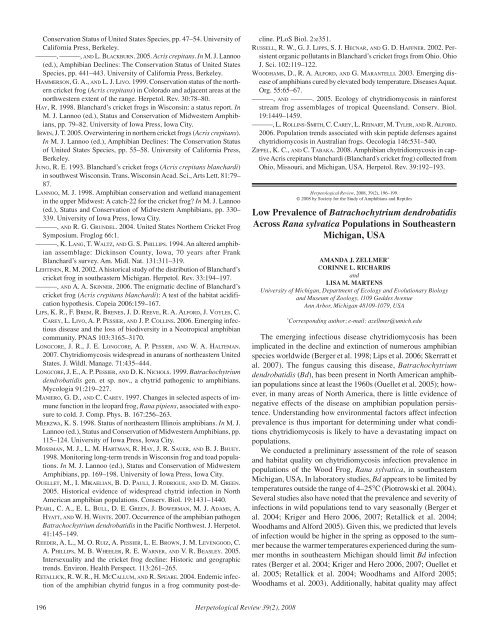Herpetological Review Herpetological Review - Doczine
Herpetological Review Herpetological Review - Doczine
Herpetological Review Herpetological Review - Doczine
Create successful ePaper yourself
Turn your PDF publications into a flip-book with our unique Google optimized e-Paper software.
Conservation Status of United States Species, pp. 47–54. University ofCalifornia Press, Berkeley.––––––, ––––––, AND L. BLACKBURN. 2005. Acris crepitans. In M. J. Lannoo(ed.), Amphibian Declines: The Conservation Status of United StatesSpecies, pp. 441–443. University of California Press, Berkeley.HAMMERSON, G. A., AND L. J. LIVO. 1999. Conservation status of the northerncricket frog (Acris crepitans) in Colorado and adjacent areas at thenorthwestern extent of the range. Herpetol. Rev. 30:78–80.HAY, R. 1998. Blanchard’s cricket frogs in Wisconsin: a status report. InM. J. Lannoo (ed.), Status and Conservation of Midwestern Amphibians,pp. 79–82. University of Iowa Press, Iowa City.IRWIN, J. T. 2005. Overwintering in northern cricket frogs (Acris crepitans).In M. J. Lannoo (ed.), Amphibian Declines: The Conservation Statusof United States Species, pp. 55–58. University of California Press,Berkeley.JUNG, R. E. 1993. Blanchard’s cricket frogs (Acris crepitans blanchardi)in southwest Wisconsin. Trans. Wisconsin Acad. Sci., Arts Lett. 81:79–87.LANNOO, M. J. 1998. Amphibian conservation and wetland managementin the upper Midwest: A catch-22 for the cricket frog? In M. J. Lannoo(ed.), Status and Conservation of Midwestern Amphibians, pp. 330–339. University of Iowa Press, Iowa City.––––––, AND R. G. GRUNDEL. 2004. United States Northern Cricket FrogSymposium. Froglog 66:1.––––––, K. LANG, T. WALTZ, AND G. S. PHILLIPS. 1994. An altered amphibianassemblage: Dickinson County, Iowa, 70 years after FrankBlanchard’s survey. Am. Midl. Nat. 131:311–319.LEHTINEN, R. M. 2002. A historical study of the distribution of Blanchard’scricket frog in southeastern Michigan. Herpetol. Rev. 33:194–197.––––––, AND A. A. SKINNER. 2006. The enigmatic decline of Blanchard’scricket frog (Acris crepitans blanchardi): A test of the habitat acidificationhypothesis. Copeia 2006:159–167.LIPS, K. R., F. BREM, R. BRENES, J. D. REEVE, R. A. ALFORD, J. VOYLES, C.CAREY, L. LIVO, A. P. PESSIER, AND J. P. COLLINS. 2006. Emerging infectiousdisease and the loss of biodiversity in a Neotropical amphibiancommunity. PNAS 103:3165–3170.LONGCORE, J. R., J. E. LONGCORE, A. P. PESSIER, AND W. A. HALTEMAN.2007. Chytridiomycosis widespread in anurans of northeastern UnitedStates. J. Wildl. Manage. 71:435–444.LONGCORE, J. E., A. P. PESSIER, AND D. K. NICHOLS. 1999. Batrachochytriumdendrobatidis gen. et sp. nov., a chytrid pathogenic to amphibians.Mycologia 91:219–227.MANIERO, G. D., AND C. CAREY. 1997. Changes in selected aspects of immunefunction in the leopard frog, Rana pipiens, associated with exposureto cold. J. Comp. Phys. B. 167:256–263.MIERZWA, K. S. 1998. Status of northeastern Illinois amphibians. In M. J.Lannoo (ed.), Status and Conservation of Midwestern Amphibians, pp.115–124. University of Iowa Press, Iowa City.MOSSMAN, M. J., L. M. HARTMAN, R. HAY, J. R. SAUER, AND B. J. BHUEY.1998. Monitoring long-term trends in Wisconsin frog and toad populations.In M. J. Lannoo (ed.), Status and Conservation of MidwesternAmphibians, pp. 169–198. University of Iowa Press, Iowa City.OUELLET, M., I. MIKAELIAN, B. D. PAULI, J. RODRIGUE, AND D. M. GREEN.2005. Historical evidence of widespread chytrid infection in NorthAmerican amphibian populations. Conserv. Biol. 19:1431–1440.PEARL, C. A., E. L. BULL, D. E. GREEN, J. BOWERMAN, M. J. ADAMS, A.HYATT, AND W. H. WENTE. 2007. Occurrence of the amphibian pathogenBatrachochytrium dendrobatidis in the Pacific Northwest. J. Herpetol.41:145–149.REEDER, A. L., M. O. RUIZ, A. PESSIER, L. E. BROWN, J. M. LEVENGOOD, C.A. PHILLIPS, M. B. WHEELER, R. E. WARNER, AND V. R. BEASLEY. 2005.Intersexuality and the cricket frog decline: Historic and geographictrends. Environ. Health Perspect. 113:261–265.RETALLICK, R. W. R., H. MCCALLUM, AND R. SPEARE. 2004. Endemic infectionof the amphibian chytrid fungus in a frog community post-decline.PLoS Biol. 2:e351.RUSSELL, R. W., G. J. LIPPS, S. J. HECNAR, AND G. D. HAFFNER. 2002. Persistentorganic pollutants in Blanchard’s cricket frogs from Ohio. OhioJ. Sci. 102:119–122.WOODHAMS, D., R. A. ALFORD, AND G. MARANTELLI. 2003. Emerging diseaseof amphibians cured by elevated body temperature. Diseases Aquat.Org. 55:65–67.––––––, AND ––––––. 2005. Ecology of chytridiomycosis in rainforeststream frog assemblages of tropical Queensland. Conserv. Biol.19:1449–1459.––––––, L. ROLLINS-SMITH, C. CAREY, L. REINART, M. TYLER, AND R. ALFORD.2006. Population trends associated with skin peptide defenses againstchytridiomycosis in Australian frogs. Oecologia 146:531–540.ZIPPEL, K. C., AND C. TABAKA. 2008. Amphibian chytridiomycosis in captiveAcris crepitans blanchardi (Blanchard's cricket frog) collected fromOhio, Missouri, and Michigan, USA. Herpetol. Rev. 39:192–193.<strong>Herpetological</strong> <strong>Review</strong>, 2008, 39(2), 196–199.© 2008 by Society for the Study of Amphibians and ReptilesLow Prevalence of Batrachochytrium dendrobatidisAcross Rana sylvatica Populations in SoutheasternMichigan, USAAMANDA J. ZELLMER *CORINNE L. RICHARDSandLISA M. MARTENSUniversity of Michigan, Department of Ecology and Evolutionary Biologyand Museum of Zoology, 1109 Geddes AvenueAnn Arbor, Michigan 48109-1079, USA*Corresponding author; e-mail: azellmer@umich.eduThe emerging infectious disease chytridiomycosis has beenimplicated in the decline and extinction of numerous amphibianspecies worldwide (Berger et al. 1998; Lips et al. 2006; Skerratt etal. 2007). The fungus causing this disease, Batrachochytriumdendrobatidis (Bd), has been present in North American amphibianpopulations since at least the 1960s (Ouellet et al. 2005); however,in many areas of North America, there is little evidence ofnegative effects of the disease on amphibian population persistence.Understanding how environmental factors affect infectionprevalence is thus important for determining under what conditionschytridiomycosis is likely to have a devastating impact onpopulations.We conducted a preliminary assessment of the role of seasonand habitat quality on chytridiomycosis infection prevalence inpopulations of the Wood Frog, Rana sylvatica, in southeasternMichigan, USA. In laboratory studies, Bd appears to be limited bytemperatures outside the range of 4–25°C (Piotrowski et al. 2004).Several studies also have noted that the prevalence and severity ofinfections in wild populations tend to vary seasonally (Berger etal. 2004; Kriger and Hero 2006, 2007; Retallick et al. 2004;Woodhams and Alford 2005). Given this, we predicted that levelsof infection would be higher in the spring as opposed to the summerbecause the warmer temperatures experienced during the summermonths in southeastern Michigan should limit Bd infectionrates (Berger et al. 2004; Kriger and Hero 2006, 2007; Ouellet etal. 2005; Retallick et al. 2004; Woodhams and Alford 2005;Woodhams et al. 2003). Additionally, habitat quality may affect196 <strong>Herpetological</strong> <strong>Review</strong> 39(2), 2008














